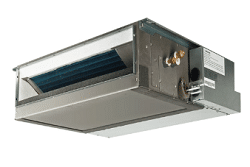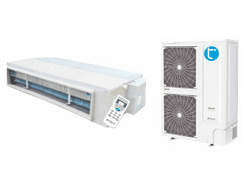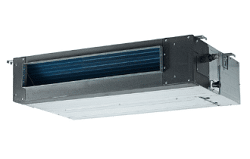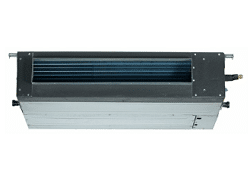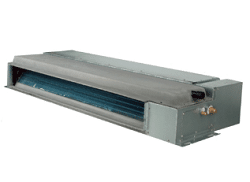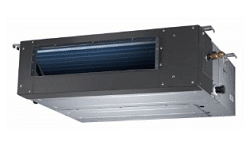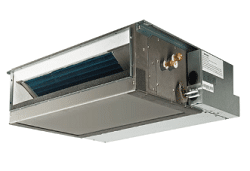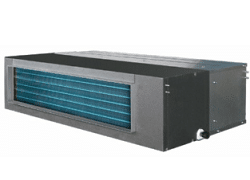TOP-8 rating of channel air conditioners. Selection tips and review, their characteristics, pros and cons
Ducted air conditioners have long occupied a leading position among a large range of designs to maintain a comfortable climate. To choose the best device, you need to take into account many parameters and consider the models offered by different companies.
The issue of ventilation and air conditioning is acute at the design stage and during major repairs.
Often, professionals recommend installing canal air conditioners, effectively handling complex tasks.
Devices are widely used to create a comfortable microclimate in rooms with suspended ceilings without compromising the design and can be used both in apartments with high ceilings and in private homes.
What is a duct air conditioner?
Design consists of outdoor and indoor units and performs tasks such as cooling, heating, air purification and dehumidification.
A distinctive feature of the equipment is the location of the indoor unit above the false ceiling.
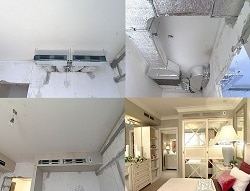
It is important to remember that the device requires complex installation, so it can only be installed during major repairs or construction.
Principle of operation
The principle of operation of duct-type air conditioners consists in the transfer of air masses with the help of air ducts and special shafts.
The outer part of the air conditioning device takes air from the street, after which it passes to the indoor unit, heating up or cooling down.
The process of air compression takes place in the external radiator of the structure, as a result of which its temperature rises rapidly.
Due to the temperature difference between the hot air and the cold outside air mass, heat exchange occurs.
Due to the throttle installed at the outlet, the pressure in the radiator rises, and gradually the accumulated air is compressed.
The gas formed in the process seeps into the radiator through the tube, filling the entire capacity of the evaporator.
The gas then cools down and is reheated by the indoor air blown by the fan.
When heated, the gas begins to move and passes into the compressor, after which the cycle repeats.
Advantages and disadvantages of devices
- the possibility of air conditioning several rooms;
- high performance and reliability;
- the presence of a hidden indoor unit;
- efficient air distribution;
- the possibility of combining the system with ventilation;
- work with low sound levels.
Among disadvantages of this technique professionals distinguish:
- the impossibility of creating different temperature regimes in neighboring rooms;
- high demands on design and difficult installation;
the need to equip suspended structures to mask the channels;
- high noise level if installed incorrectly.
How to choose a ducted air conditioner?
Key selection criteria channel split systems are:
- cooling and heating capacity;
- maximum airflow;
- number of operating modes and options;
- availability of a reliable security system;
- length of communications;
- the presence of additional functions;
- the level of emitted noise;
- construction dimensions.
Popular Models
To get acquainted with the technical parameters, advantages and disadvantages of modern split systems, as well as to decide on the choice of a duct air conditioner, a review and rating of the most interesting models according to reviews and evaluations of customers on the modern market will help.
#1
Timberk AC TIM 24LC DT5
A presentable model that successfully combines functionality, versatility and laconic design.
Powerful unit for heating and cooling air, highly efficient in large areas.
The equipment has three degrees of fan speed adjustment, quickly copes with the tasks set, without making excessive noise even at maximum power.
In the event of a malfunction, the device automatically performs diagnostics.
Specifications:
- cooling power - 7200 W;
- heating power - 8080 W;
- airflow - 23.33 cu. m/min;
- communications length - 30 m;
- maximum noise level - 47 dB.
Advantages
- economical energy consumption;
- automatic fault diagnosis;
- prevention of ice formation;
- simple adjustment of the direction of air flow;
- silent operation at night.
Flaws
- installation requires the intervention of a professional;
- high price;
- there is no automatic cleaning mode.
#2
Timberk AC TIM 48LC DT1
The high-performance unit which is not demanding special service and leaving.
An advanced device that has the ability to distribute processed air through the air duct system and is equipped with an additional protection system against condensate leakage.
This guarantees long and trouble-free operation of the device.
The device is able to maintain the set temperature and has a self-diagnosis function.
Specifications:
- cooling power - 14000 W;
- heating power - 14000 W;
- airflow - 53.5 cu. m/min;
- communications length - 30 m;
- maximum noise level - 45 dB.
Advantages
- increased reliability;
- high level of security;
- the presence of an anti-corrosion coating;
- the possibility of forced ventilation;
- intuitive control.
Flaws
- noise at maximum power;
- meager equipment;
- the device does not cope well with increased dampness.
#3
Hyundai H-ALD3-36H
A worthy model from a trusted manufacturer, famous for the development of innovative equipment for a comfortable life.
Medium pressure duct type air conditioner used for servicing commercial, residential and industrial premises.
The device is perfectly prepared for operation at low temperatures, so the user does not have to worry about the likelihood of breakdowns in the cold season.
Specifications:
- cooling power - 10500 W;
- heating power - 12000 W;
- airflow - 30 cu. m/min;
- communications length - 30 m;
- maximum noise level - 45 dB.
Advantages
- effective dehumidification;
- built-in display;
- three fan speeds;
- automatic maintenance of a comfortable temperature;
- environmental resistance.
Flaws
- high power consumption;
- the cost is higher than similar models;
- slow air distribution.
#4
Hyundai H-ALD3-48H
Modern climatic equipment designed to improve the microclimate in large rooms.
Presentable device belonging to the premium segment, equipped with all the necessary options to instantly create a healthy microclimate.
The unit is equipped with an automatic night-time mode, quickly reaches maximum power and is able to heat the room at an outdoor temperature of up to -7 degrees.
Specifications:
- cooling power - 14000 W;
- heating power - 16000 W;
- airflow - 29.17 cu. m/min;
- communications length - 50 m;
- maximum noise level - 45 dB.
Advantages
- environmentally friendly refrigerant;
- fast switching modes;
- high performance;
- economical energy consumption;
- long warranty period.
Flaws
- non-informative instruction;
- lack of auto-cleaning mode;
- insufficient air filtration.
#5
Hisense AUD-12HX4SNL
The original semi-industrial gadget with advanced functionality.
Standard non-inverter model designed for efficient air conditioning of various rooms.
The model is equipped with a condensate level controller and is complemented by a wired remote control. Polystyrene drain pan available.
Specifications:
- cooling power - 3520 W;
- heating power - 3810 W;
- airflow - 10.83 cu. m/min;
- communications length - 15 m;
- maximum noise level - 34 dB.
Advantages
- auto-restart of the system in case of malfunctions;
- uniform air distribution;
- reduced level of sound power;
- thoughtful equipment;
- fault diagnosis function.
Flaws
- small radius of action;
- slow switching modes;
- problematic setup.
#6
Lessar LS-HE12DOA2 / LU-HE12UOA2
Heavy duty design with long service life and affordable price.
A technological gadget with the function of automatic search and maintenance of the optimal temperature set by the user.
One of the main advantages of the equipment is ease of operation and maintenance, which means that working with the device does not require special skills and special knowledge.
Specifications:
- cooling power - 3520 W;
- heating power - 3810 W;
- airflow - 10.33 cu. m/min;
- communications length - 25 m;
- maximum noise level - 40 dB.
Advantages
- three fan speeds;
- simple control;
- innovative anti-ice system;
- work at low temperatures;
- efficient dehumidification.
Flaws
- high electricity consumption;
- short warranty period.
#7
Timberk AC TIM 36LC DT5
Channel-type unit, which is perfect for installation in large areas.
A well thought-out split system with a preset on/off timer, night mode and the possibility of forced ventilation.
Thanks to the increased efficiency of heat exchange and low power consumption, the device is very economical and productive.
Specifications:
- cooling power - 10600 W;
- heating power - 11700 W;
- airflow - 33.33 cu. m/min;
- communications length - 50 m;
- maximum noise level - 50 dB.
Advantages
- 24 hour timer;
- the presence of a convenient remote control;
- elimination of unpleasant odors;
- choice of air flow direction;
- versatility of use.
Flaws
- cost of equipment;
- equipment;
- costly repairs.
#8
Electrolux EACD-18H/UP2/N3
A high-performance model capable of creating ideal conditions for a comfortable life.
The unit with the function of remembering settings, equipped with a fault diagnosis program and the ability to independently adjust the direction of air flow, choosing the best option.
In addition to standard modes, the air conditioner can operate in night mode.
Specifications:
- cooling power - 5000 W;
- heating power - 5500 W;
- airflow - 14167 cu. m/min;
- communications length - 20 m;
- maximum noise level - 52 dB.
Advantages
- work in ventilation mode;
- convenient control system;
- option to remember user-selected settings;
- a large selection of operating modes;
- high energy efficiency class.
Flaws
- long pause when changing modes;
- the appliance does not work in dehumidification mode;
- lack of air ionization function.
Reviews
This review has no replies yet.
conclusions
When planning to purchase a duct-type air conditioner, you need to remember that:
- main selection criteria are cooling and heating power, generated air pressure and length of communications;
- take account of also should options such as dimensions of the equipment and the level of noise emitted during operation;
- pay attention to the energy efficiency class and the maximum serviced area;
- for comfortable work with the device, it is better to give preference to a high-power model with several operating modes and an on / off timer.
Useful video
This video provides an overview of the duct inverter air conditioner from Gree U-Match series:



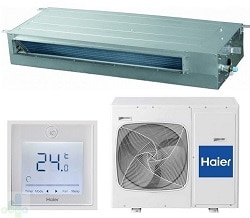 the need to equip suspended structures to mask the channels;
the need to equip suspended structures to mask the channels;